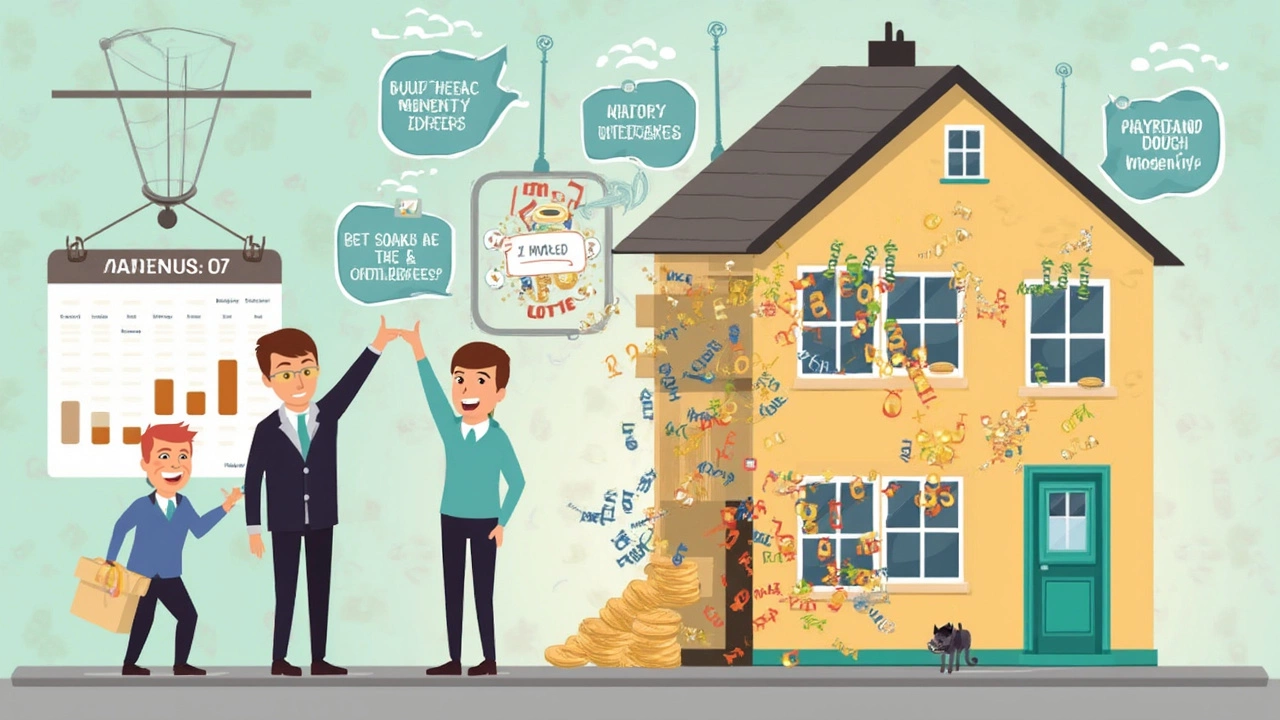You’re probably not looking to throw away money every month, especially when it comes to housing. If you’re eyeing a $150,000 mortgage, the payment depends on three things: the interest rate, the loan term, and a handful of extras like taxes and insurance. Most people forget that the sticker price isn’t the full story.
Picture this: With today's average rates hovering around 6.5% for a 30-year fixed mortgage, your monthly payment for the loan alone lands close to $948. But if you take a 15-year term, that payment jumps to about $1,307—bigger bite now, but a lot less paid in interest over the long haul. And remember, banks usually want you to add property tax and homeowner’s insurance on top, so don’t just budget for the base payment.
- Breaking Down a $150,000 Mortgage Payment
- How Loan Term Affects Your Monthly Bill
- Impact of Interest Rates in 2025
- Cutting Costs: Remortgaging and Other Tips
- Crunch the Numbers: Use a Mortgage Calculator
Breaking Down a $150,000 Mortgage Payment
Let’s talk about what actually makes up your payment each month. When you get a $150,000 mortgage, your monthly bill is built from four main pieces: principal, interest, property taxes, and homeowner’s insurance. Lenders call this your PITI—Principal, Interest, Taxes, and Insurance. Most people just focus on the money going toward the house, but your total payment is a package deal.
The biggest chunks are principal (the amount you borrowed) and interest (the bank’s fee for lending you cash). These two bits are what show up in those online calculators you see everywhere. But, if you skip the taxes and insurance, your budget might come up short real fast.
- Monthly payments on a $150,000 mortgage with a 6.5% rate over 30 years typically land around $948 for principal and interest.
- Add property taxes: These vary by state and city, but U.S. homeowners usually pay between $100 and $300 per month.
- Homeowner’s insurance adds another $75–$100 monthly on average.
So, your actual total payment each month is almost always more than what the mortgage calculator spits out.
Check out how the numbers might look for a $150,000 loan at 6.5% interest:
| Component | Monthly Amount (Est.) |
|---|---|
| Principal & Interest | $948 |
| Property Tax | $150 |
| Homeowner’s Insurance | $85 |
| Total Payment | $1,183 |
If your taxes or insurance are higher in your area, expect your payment to go up. The breakdown is different for everyone, but knowing what lurks in your monthly bill keeps the surprises at bay.
How Loan Term Affects Your Monthly Bill
The loan term—from 10 to 30 years—makes a massive difference in your monthly outlay and how much you pay in interest overall. Shorter terms mean you pay less total interest, but your monthly bill goes up. Longer terms shrink that payment, but you give the bank a chunk more money in the end.
Let’s break it down with a $150,000 mortgage and today’s average rates. If you pick a 30-year fixed deal at 6.5%, your payment comes out lower, but the interest adds up. On a 15-year fixed at 6%, you get a bigger bill every month, but you’re debt-free years earlier and the savings are real.
| Loan Term | Interest Rate | Monthly Payment | Total Interest Paid |
|---|---|---|---|
| 30 Years | 6.5% | $948 | $191,293 |
| 15 Years | 6.0% | $1,266 | $77,842 |
See the difference? That’s $113,000 less paid in interest—just for choosing a shorter term. But for a lot of folks, that extra $318 per month makes a 15-year mortgage a hard sell. It comes down to what you can realistically afford every month.
- If you’re looking to keep your monthly payments as low as possible for now, a 30-year term keeps money in your pocket short term.
- If you want to build home equity fast and save a ton on interest, shooting for a 15-year term pays off in the long run.
Don’t forget, you can usually pay a little more than your minimum payment on a 30-year loan to chip away at the balance faster—but you’re not on the hook for the bigger bill each month. For many, it’s about flexibility.

Impact of Interest Rates in 2025
Mortgage rates have a bigger effect on your payment than you might think. In 2025, average rates for a 30-year fixed mortgage in the U.S. have been hovering between 6.3% and 6.7%. This is a lot higher than just a few years ago when people were locking in rates under 4%. Those changes can mean hundreds of dollars more every month on the same loan amount.
Let’s look at what the monthly payment looks like on a $150,000 mortgage at different rates for a 30-year fixed term. These numbers only cover principal and interest:
| Interest Rate | Monthly Payment |
|---|---|
| 5.0% | $805 |
| 6.0% | $899 |
| 6.5% | $948 |
| 7.0% | $997 |
A one percent jump in the rate adds almost $100 to your monthly bill. Over 30 years, that’s basically a used car—or even a full kitchen remodel—down the drain in extra interest.
Don’t forget, if you’re remortgaging in 2025, lenders will look at your credit score, loan-to-value ratio, and even your job stability. A good credit score (think 740 or higher) can sometimes save you half a percentage point or more on the interest rate. That’s real money in your pocket, every month.
Want to snag a lower rate? Keep your debt low, pay your bills on time, and shop around. Different banks may offer surprisingly different deals, especially if you’ve been with one lender a long time. Always ask for a quote from at least three lenders before settling.
Cutting Costs: Remortgaging and Other Tips
If your monthly payments on a $150,000 mortgage are getting hard to handle, remortgaging could save you a good chunk of change. In fact, more than 40% of homeowners in the U.S. have remortgaged at least once to snag a better rate or free up extra cash. How much you can save depends on rates, fees, and your current situation, but here's what you need to know right now.
2025 rates are still higher than the rock-bottom lows from a few years ago, but if your credit has improved, or if you took on your loan when rates were even higher, remortgaging lets you lock in something better. Don’t forget that most lenders want to see at least 20% equity in your home before they’ll offer their best deals. And watch for fees—most lenders charge around 2% to 5% of the loan amount for closing costs.
| Scenario | Monthly Payment | Interest Rate | Total Interest (30 years) |
|---|---|---|---|
| Original Mortgage | $948 | 6.5% | $191,386 |
| After Remortgaging | $843 | 5.25% | $153,484 |
That table shows what happens if you remortgage from 6.5% to 5.25% on $150,000—your monthly payment could drop by over $100, and your total interest paid would shrink by nearly $38,000. Of course, you have to factor in closing costs, but long-term, it usually pays off if you stick around in the house 3 years or more.
Besides remortgaging, check out these cost-cutting moves:
- Eliminate private mortgage insurance: Once your equity hits 20%, ask your lender to remove PMI if you’re still paying it.
- Shop for better homeowner’s insurance: Prices vary wildly. Call around yearly—savings here go straight to your pocket.
- Make extra payments: Even adding $50 a month to your principal trims years off your loan and saves heaps on interest.
- Tackle expensive debt first: If credit cards or car loans are draining your finances, paying those off can help you qualify for a better remortgage rate later.
Every little bit you can cut frees up space in your budget. Don’t just set your payments and forget them—tweaking your loan and related bills adds up faster than you’d think.

Crunch the Numbers: Use a Mortgage Calculator
Doing the math by hand is a pain, and a lot of people end up guessing when they don’t need to. That’s why mortgage calculators are game changers. You just type in your numbers—like the amount you want to borrow, the current interest rate, and your loan term. The calculator spits out your monthly payment in seconds. It’s seriously useful if you’re comparing options or thinking about remortgaging.
Here’s what tends to trip people up: calculators use principal and interest by default, but your bank will add property tax and insurance to your monthly payment, and those can really add up. Don’t skip those when plugging in your numbers.
Let’s see how things shake out for a monthly payments on a $150,000 mortgage using 2025’s average rates. Check the table below for a quick side-by-side:
| Loan Term | Interest Rate | Monthly Principal & Interest | Est. Taxes & Insurance* | Total Estimated Payment |
|---|---|---|---|---|
| 30 years | 6.5% | $948 | $220 | $1,168 |
| 15 years | 5.9% | $1,262 | $220 | $1,482 |
*Taxes and insurance are rough estimates based on national averages. Your numbers can be higher or lower depending on where you live and the coverage you’re picking.
- If you plan to refinance or remortgage soon, play around with the calculator and adjust for future rates. Even a 0.5% change can bump your payment by $50 or more.
- Check if your lender includes private mortgage insurance (PMI) and see how that changes the outcome.
- Don’t just look at the payment—check how much total interest you’ll end up paying over the full life of the loan. That’s often an eye opener.
Bottom line: Take five minutes to plug your numbers into a reputable online calculator before signing any paperwork. It gives you a reality check and saves you from surprises down the road.

